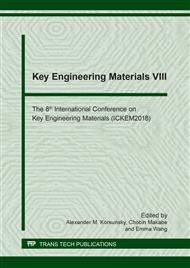[1]
Poblete M., and Diaz, L. (2014). Synthesis of Biodegradable Cellulose-Chitin Polymer Blend from Portunus pelagicus. Advanced Materials Research, 925, pp.379-348.
DOI: 10.4028/www.scientific.net/amr.925.379
Google Scholar
[2]
Minford J. D. (1981). Aluminum adhesive bond permanence, in: Treatise on Adhesion and Adhesives (R. L.Patrick, cd.), Vol. 5, Chapter 3, p.45, Marcel Dekker, New York.
Google Scholar
[3]
ASTM. (2008). Standard Test Method for Measuring Adhesion of Organic Coatings to Plastic Substrates by Direct Tensile Testing (D5179-02). Conshohocken, PA: American Society for Testing and Materials International.
DOI: 10.1520/d5179-98
Google Scholar
[4]
Lee, L-H. (1991). Adhesive Bonding. Published by Plenum Press, New York.
Google Scholar
[5]
ASTM. (2014). Standard Test Method for Tensile Properties of Plastics (D638-14). Conshohocken, PA: American Society for Testing and Materials International.
Google Scholar
[6]
ASTM. (2012). Standard Test Method for Tensile Properties of Thin Plastic Sheeting (D882-12). Conshohocken, PA: American Society for Testing and Materials International.
Google Scholar
[7]
Macailing, M. (2015). Synthesis and characterization of chitin-cellulose nanocomposite laminates. UP Diliman.
Google Scholar
[8]
Poblete, M.S. (2013). Synthesis of biodegradable cellulose-chitin polymer blend film. UP Diliman.
Google Scholar
[9]
McMurry, J. (2008). Organic Chemistry. Belmont, CA: Brooks/Cole Pub. Co., pp.973-1007.
Google Scholar
[10]
Santha, N., Sudha, K. G., Vijaykumari, K. P., Nayar, V. U., Moorthy, S. N. (1990). Raman and Infrared spectra of starch samples of sweet potato and cassava. Journal of Chemical Sciences 102, pp.705-712.
DOI: 10.1007/bf03040801
Google Scholar
[11]
Poletto, M., Orgnaghi, H., and Zattera, A. (2014). Native Cellulose: Structure, Characterization, and Thermal Properties. Materials, 7, pp.6105-6119.
DOI: 10.3390/ma7096105
Google Scholar
[12]
Zhang, S., Li, F., and Yu, J. Preparation of Cellulose/Chitin Blend Bio-fibers via Direct Dissolution. Cellulose Chemistry and Technology. 43, 9-10, pp.393-398.
Google Scholar
[13]
Long, H., Wu, P., and Zhu, N. (2013). Evaluation of Cs+ Removal from Aqueous Solution by Adsorption on Ethylamine- Modified Montmorillonite. Chemical Engineering Journal, Vol. 225, 237-244.
DOI: 10.1016/j.cej.2013.03.088
Google Scholar
[14]
Nelson G.L. (2012). Adhesion. Manual 17-EB. American Society for Testing and Materials International.
Google Scholar


